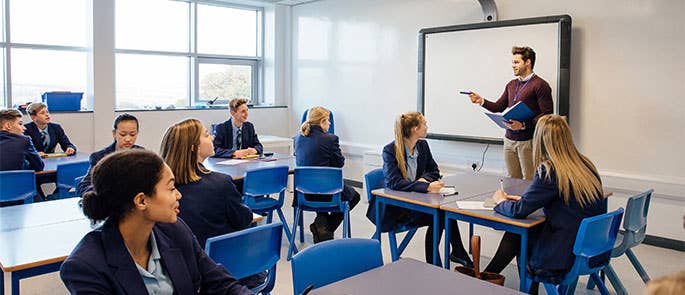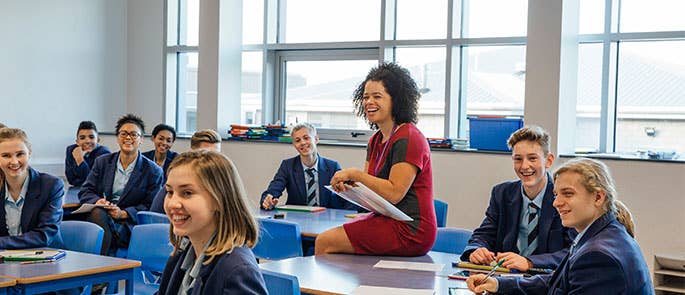How to Become a Secondary School Teacher
Secondary school teachers work with students aged 11 to 18, honing the foundational skills that they gained in primary school. Secondary school teachers often have more indepth knowledge on a given subject and will therefore focus on teaching one specific subject. This enables them to pass on their expert knowledge and passion to the next generation.
Secondary school teachers play a pivotal role in their students’ lives as they guide them from childhood to young adulthood, readying them for life outside the classroom. Their encouragement and positive influence can help to shape a child’s future, inspiring them to pursue a particular career or area of further academic study. In this article we will cover the key roles and responsibilities of a secondary school teacher and the skills and qualifications necessary to become a secondary school teacher.

Roles and Responsibilities of a Secondary School Teacher
Students in England start secondary school when they are 11 years old. Throughout secondary school students are taught by subject specialists, rather than being taught several subjects by one individual. As such, whilst there is a lot of cross over between the roles and responsibilities of a primary school teacher and a secondary school teacher, a secondary school teacher should expect to have extensive knowledge of the subject they wish to teach.
The responsibilities of a secondary school teacher will vary according to the key stage that they teach and the subject they specialise in. However, the core responsibilities of a secondary school teacher include:
- Planning and teaching lessons
- Preparing teaching materials and activities
- Marking work
- Talking to parents and carers about their child’s progress
- Organising trips, after school activities and sports events
- Managing the work of teaching assistants
- Following safeguarding procedures and statutory safeguarding guidance such as Keeping Children Safe in Education (KCSIE)
Schools in England are grouped by years into blocks called key stages and each key stage has its own developmental focus. There are three key stages in secondary school. Key stage 3 (KS3) includes years 7 to 9, key stage 4 (KS4) includes years 10 and 11 and key stage 5 (KS5) includes years 12 and 13. In KS5 students are typically working towards A Levels, T Levels or other equivalent qualifications either within school at sixth form or at a college.
Key Stage 3 (KS3) 
KS3 includes years 7 to 9 and children aged 11 to 14. When students begin KS3 it is often their first exposure to a broader academic curriculum. Throughout secondary school a child will be encouraged to develop their independence and this expectation begins in KS3. Schools that teach the national curriculum will teach KS3 pupils a range of compulsory subjects including:
- English
- Maths
- Science
- History
- Geography
- Modern Foreign Languages (French, German, Spanish)
- Design and Technology
- Art and Design
- Music
- Physical Education
- Citizenship
- Computing
All state-funded schools must also teach religious education and relationships, sex and health education.
Key Stage 4 (KS4) 
KS4 includes years 10 and 11 and pupils aged 14 to 16. Most pupils work towards their GCSEs or an equivalent national qualification during KS4, gaining a deeper insight and understanding into a select number of subjects. Whilst some subjects are compulsory at this stage, KS4 provides students with more choice over what subjects they choose to pursue. The amount of choice that a student will have regarding the GCSEs they choose will differ based on the environment. For example, some schools may make additional subjects compulsory that the national curriculum does not. Moreover, students at an independent school may have more freedom in their choice of subjects as they are not required to follow the national curriculum.
Compulsory KS4 subjects for schools that teach the national curriculum include:
- English
- Maths
- Science
- Computing
- Physical Education
- Citizenship
Pupils can then choose from a selection of subjects offered by their school. Maintained schools must offer at least one subject from each of the following areas:
- Arts (art and design, music, dance, drama)
- Design and Technology
- Humanities (history and geography)
- Modern Foreign Languages
All state-funded schools must also teach religious education and relationships, sex and health education.
Key Stage 5 (KS5) 
KS5 includes years 12 and 13 and pupils aged 16 to 18. At this age students may be at a college or in school at sixth form. Most KS5 students will be working towards their A Levels, T Levels or an equivalent qualification. At this stage students are encouraged to follow their own interests. The choices that they make at this age, regarding their subjects and qualifications, will impact their future choices such as whether they apply to university, pursue an apprenticeship or start employment.
Additional Responsibilities of a Secondary School Teacher
As mentioned, there is notable crossover in the roles and responsibilities of a primary school teacher and a secondary school teacher. However, it would be short sighted to ignore the main difference between the two; the age of pupils. Secondary school teachers don’t just offer more specialist knowledge, they are preparing students for life outside of school. As students grow and go through puberty, their interests and opinions shift and it’s natural for them to develop a curiosity about more adult topics such as politics, sex and relationships. As a secondary school teacher it is important that you are well equipped to approach these topics in an informative and age appropriate manner.
A 2024 survey from the Department for Education (DfE) reported that for some primary school teachers, concerns about managing more challenging behaviour amongst pupils was a notable barrier to them moving to teach in secondary schools. It’s important to note that as a secondary school teacher you will be working with pupils as they go through puberty and early adulthood, which can be both an exciting and emotionally turbulent time for them. This can lead to additional responsibilities for secondary school teachers as they help pupils navigate new emotions, bodily changes and an increased curiosity about life outside of the classroom.
As a secondary school teacher you may find yourself addressing topics such as:
- Vaping
- Drug use
- Peer pressure
- Bullying
- Sextortion
- Incel culture
- Radicalisation
- Misogyny
- Screen addiction
- Sex and sexuality
- LGBTQ+ education
- Gender dysphoria
- Self harming
The list above is not exhaustive, nor is it exclusive to secondary schools. However, it is highly likely that a secondary school teacher will engage with these topics in some way throughout their career. It is therefore important to have a thorough understanding of these topics and how it can impact your students. High Speed Training has a wide range of articles that can help you to gain vital knowledge and understanding of these topics. You can find links to these articles in the Further Resources section.

How to Become a Secondary School Teacher
There are three main ways you can become a secondary school teacher. These are:
- A university course
- An apprenticeship
- Working towards the role
You can also become a secondary school teacher if you are currently working as a primary school teacher in a state school. As a primary school teacher you will already have Qualified Teacher Status (QTS) which you need to become a secondary school teacher. However, you may have to become a subject expert and complete a subject knowledge enhancement (SKE) course before you can do so. This will be explored in more detail later in the article.
The route that you take to become a secondary school teacher will impact the qualifications you attain and the qualifications you need. For example, if you completed an undergraduate degree in History which did not result in QTS, you can still apply to work at an independent school or academy. However, if you wanted to teach at a state school you would then need to complete additional training and gain QTS. Moreover, you may gain QTS and decide that you want to work with children with special educational needs and disabilities (SEND) which may require additional qualifications so that you can fully support those students.
Your path to becoming a secondary school teacher may also be impacted by your current stage in life. If you are just beginning your career then an undergraduate degree or apprenticeship can provide you with the knowledge and experience you need before starting your career. Comparatively, if you are changing careers then you may choose to do a Postgraduate Certificate in Education (PCGE) and study around your current job before making the career change. Below you will find a breakdown of the three main ways you can become a secondary school teacher.
University
Arguably the most common way to begin a career in education is to get a degree. You can do an undergraduate degree that leads to QTS such as:
- Bachelor of Education (BEd)
- Bachelor of Art (BA) with QTS
- Bachelor of Science (BSc) with QTS
It’s important to note that if you pursue a BA or BSc with the goal to become a teacher you need to ensure that the course results in QTS or you will need to complete a PGCE.
A PCGE can be pursued if you have a bachelor’s degree without qualified teacher status. A PGCE can be done at university or through a training programme based in a school. To pursue a PGCE you need to have an undergraduate degree in any subject.
Different courses will have different requirements however you will usually need:
- 5 GCSEs at grades 9 – 4 (A* to C) or equivalent (including maths and English)
- 2 – 3 A Levels, or equivalent
- A degree in any subject (the grade criteria of your degree will vary depending on where you choose to complete your PGCE)
Remember, secondary school teachers often have specialised knowledge on a given subject. Whilst an SKE course will enable you to teach a subject you didn’t necessarily study at university, it’s a good idea to choose your undergraduate degree based on what you will want to teach.
Apprenticeship
If you do not have a degree then you may be eligible to do a teacher degree apprenticeship (TDA). A TDA is a four year, full time teacher training programme that offers an alternative route to becoming a qualified teacher. You can currently do a TDA in maths from a number of selected providers. It’s worth noting that TDAs are relatively new and so the subjects that you can pursue are currently quite limited. More subjects are due to be added throughout 2025.
To be eligible for a TDA you must be:
- A resident of England for the last 3 years or more
- At least 16 years old
To meet the academic requirements for a TDA you will need:
- GCSEs at grades 9 – 4 (A* to C) in English and maths
- A Levels, or equivalent – the number you will need will be set by individual universities
Working towards the role
If you have experience working as a teaching assistant then you can develop your skills to become a qualified teacher. You will need to complete a degree, which you could do part-time whilst continuing to work as a teaching assistant. You could then move onto a postgraduate teaching course to gain QTS.
Other routes into a career as a secondary school teacher include:
School Direct – This is a salaried employment-based route for graduates with at least three years’ experience of transferable work history. School Direct gives you the chance to earn a salary while training towards your QTS without having to pay any tuition fees.
Teach First – This is a two year training programme that leads to a fully funded PGCE. In the first year of your course you will teach 80% of a fully qualified teacher’s timetable as well as attending training days and conferences. In your second year you will be an early career teacher (ECT) teaching a full timetable.
Ambition Institute – This is a 12-month, full time postgraduate course which leads to QTS and a PGCE. You will be placed in a school and receive one-on-one support from a dedicated mentor who will be an experienced teacher at the same school.

Subject Knowledge Enhancement (SKE)
If you currently work as a primary school teacher then you can develop your skills to become a secondary school teacher. To teach in a maintained primary, secondary or special school in England you need QTS. If you already have QTS from working in a primary school, then you have the necessary qualifications to become a secondary school teacher. However, you will need to demonstrate specialist subject knowledge. If you cannot demonstrate this then you might need to do an SKE course before applying for a position as a secondary school teacher. Your prospective employer may also make this a prerequisite for offering you a job. You can also complete an SKE course if you are not already a primary school teacher but want to develop your knowledge in a specific subject before applying for teaching training.
You may choose to complete an SKE course if you have:
- finished your degree more than 5 years ago
- a different but related degree to the subject you want to teach (for example, if you have a degree in engineering but want to teach physics)
- an A Level but not a degree in the subject you want to teach
- an unrelated degree but relevant professional experience
- studied for a languages degree but need to improve your knowledge either in a main language, second language or both to an acceptable level for teaching in schools
SKEs are usually completed online but some courses can be classroom based and some can be a mix of the two. Courses range in length from 8 to 28 weeks with one week equalling 25 hours of study. You can do an SKE course part-time and complete it over a longer period, or do compressed hours and complete it in a shorter period of time.
The DfE currently funds SKE courses in 5 secondary subjects:
- Chemistry
- Computing
- Languages
- Maths
- Physics
To be eligible to undertake a government funded SKE course all applicants must:
- Meet the eligibility criteria to training to teach in England
- Accept a conditional offer which specifies the requirement to complete an SKE course
The DfE does not fund SKE courses for individuals who have already obtained QTS. Nor does it fund them for those who have been awarded a degree, postgraduate degree or joint degree in their chosen subject within the last 5 years. You can only complete a funded SKE course if your training provider makes it a condition of the offer to train with them. However, you can self-fund an SKE course and numerous educational institutions across the country offer SKE courses of various lengths.
You can gain a more in depth understanding of SKEs here.
What Qualifications Do You Need to Be a Secondary School Teacher?
As mentioned above, the qualifications that you will need to train as a teacher will depend on the route you choose to take, any specialisms you decide to pursue and where you wish to teach. However, you must have QTS to teach in a maintained secondary or special school in England. Maintained schools are those that are funded by local authorities, also known as state schools.
You do not need QTS to teach in Further Education (FE). FE is any education for people aged 16 and over who aren’t studying for a degree. You also do not need QTS to teach in independent schools or academies. That being said, most schools prefer teachers to have QTS.
If you do not have QTS you will need to complete some form of teaching training as detailed above.
Each training programme will have its own requirements, however to train to teach in secondary schools in England you’ll typically need:
- GCSEs at grade 4 (C) or above in English and maths
- A bachelor’s degree in any subject – ideally this should be in the subject you wish to teach but you can complete an SKE course if this is not the case.
If you do not have a degree you can pursue one of the alternative routes listed above to attain QTS.
When starting any career it’s important that you put your best foot forward and make a good impression when applying and interviewing. It’s therefore important that your CV showcases your work experience, relevant qualifications and any valuable transferable skills that you may have. As such, you should ensure that you give your CV the time and consideration that it needs so that it can be as carefully thought out as possible. You can learn more about how to write your first CV here. Moreover, prepping for interviews by considering possible interview questions can help you to feel more confident and ensure your answers are clear and concise.
Want to Learn More?
Our comprehensive training courses can provide you with the knowledge to teach effectively and confidently. Courses such as our Safeguarding Children in Education course and Special Educational Needs and Disabilities (SEND) in the Classroom course provide you with the necessary understanding to keep children safe and support all students in the classroom. Our Child Mental Health Training course can also help you to feel confident supporting children who may be struggling with their mental health.
Secondary School Teacher Skills
There are numerous hard skills that a secondary school teacher must have. Most of these hard skills will be attained during teacher training but they can also be attained through independent learning such as online training courses. If you are changing careers, you may already possess a range of valuable transferable soft skills that will be helpful in your new career as a teacher.
There are a wide range of soft skills that it’s important for a teacher to possess. These include:
- Good communication
- Leadership
- Problem solving capabilities
- Multitasking
- Strong time management
- Emotional intelligence
- Adaptability
- Empathy
- Teamwork
- Organisational skills
- Creativity
- Patience
The list above is not exhaustive and there are numerous other soft skills that a teacher can and should have. However, those listed above can equip a teacher with the skill set to confidently manage their classroom, plan and teach engaging lessons and to communicate compassionately and effectively with students.
Secondary school teachers encourage independence and confidence, guiding the next generation of learners toward their best possible future. Working as a secondary school teacher enables you to share your passion for a specific subject and evoke a similar passion in young minds. Secondary school teachers directly influence a student’s future prospects and their enthusiasm, support and motivation can be the fuel that propels a student throughout their life.
Further Resources:
- Peer Pressure in Schools
- What is County Lines
- A Guide to Emojis and Texting Abbreviations
- Mobile Phones in Schools Debate
- Filtering and Monitoring in Schools
- Supporting Transgender Students
- How to Help a Child with Depression











